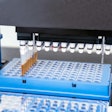
Nonimaging testing involving a sample taken from a patient is big business, according to a new report on the IVD market from market research firm Kalorama Information. The market reached $69.2 billion in 2019, including all laboratory and hospital-based IVD tests, instruments, and reagents, as well as over-the-counter product sales.
Hundreds of companies are involved in the IVD market, and there are many new entrants, along with pharmaceutical, financial, and technology companies that are playing a role, according to the annual report, which profiles more than 200 companies. Kalorama predicted the market will grow a little more than 4% annually to reach $85.2 billion by 2024, including all sales of instruments, reagents, test kits, and supplies and directly related software and services.
 Bruce Carlson of Kalorama Information.
Bruce Carlson of Kalorama Information.There have been some changes in the market since Kalorama's last report on IVD products in 2018. Key findings this year include the following:
- There are at least nine major categories of testing (core lab, point of care, molecular, immunoassay, hematology, coagulation, microbiology, blood banking, and histology) and overlap in these groups, and there are scores of subcategories within these fields. But one area stands out: Early detection demand for cancer and infectious diseases is driving the IVD market globally in many areas. Routine bloodwork, urinalysis, allergy testing, and glucose testing are stable markets. The need to address cancer detection and to combat new and threatening infections is making the case for spending on testing products.
- The market is also boosted by the aging world population and the stream of new test innovations -- this is a field where double-digit percentages of sales invested back in R&D is not uncommon.
- IVD is a global business and there have been improvements in many regions. Regionally, Europe had suffered in the past due to lab spending cuts as a result of the recession and austerity programs. However, much spending is being restored. In Japan, stagnant growth has turned to market-beating growth; 4% per year is expected for the next five years. Kalorama sees sales to China, Korea, Brazil, and other emerging nations as an important growth component.
- New technologies are part of the market growth. Mass spectrometry has arrived and is included in market totals for its superior microorganism identification capability, among other applications. Sequencing is finding use in noninvasive prenatal testing, as well as in cancer and precision medicine generally. These test innovations fetch higher pricing and help fuel market growth overall.
- Hundreds of companies compete in the market and investment is brisk. Roche dominates the market, but Abbott Diagnostics has gained ground recently. Siemens Healthineers, Danaher, Thermo Fisher Scientific, BioMérieux, and Ortho Clinical Diagnostics are among the top-tier players.
IVD testing costs little to the healthcare system and yet contributes much to clinical practice. For some time, this was stated as educated conjecture, but a study of healthcare expenditures on IVD and the effect on patient management among U.S and German physicians helped make the case. Researchers found that 66% of clinical decisions made were based on a diagnostic test, while the costs of those tests amounted to just 2.3% of healthcare expenditures (Rohr et al, PLOS One, March 4, 2016).
When the cost-effectiveness of IVD testing is considered along with the beneficial effects on treatment outcomes, therapy choices, and hospital management, there should be little surprise about the amount of interest in IVD tests and the amount of activity in the market for them, the report concluded.
Bruce Carlson is the publisher of Kalorama Information, part of Science and Medicine Group.
Disclosure: LabPulse.com is a sister company of Kalorama Information.



















